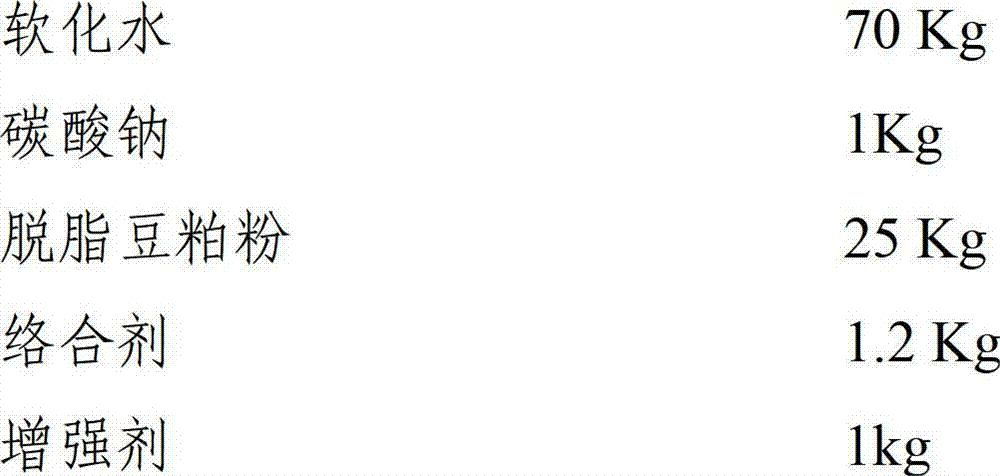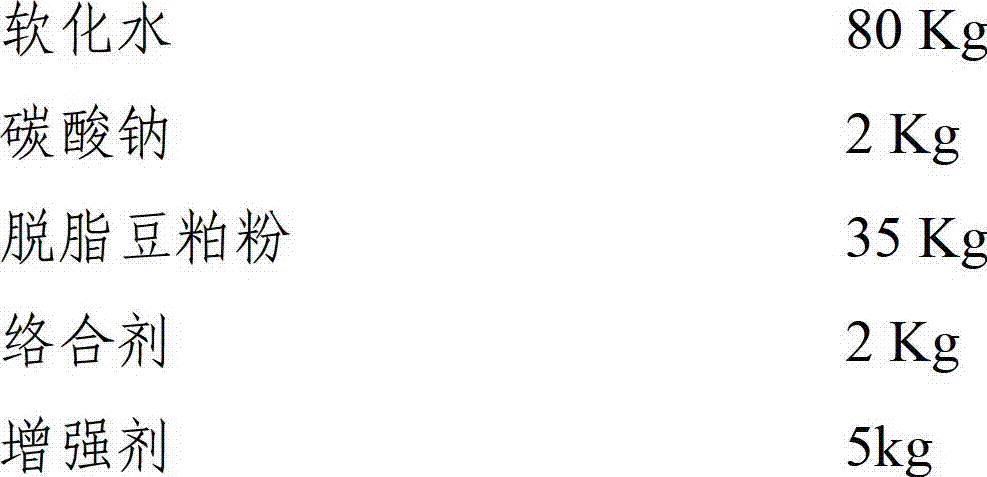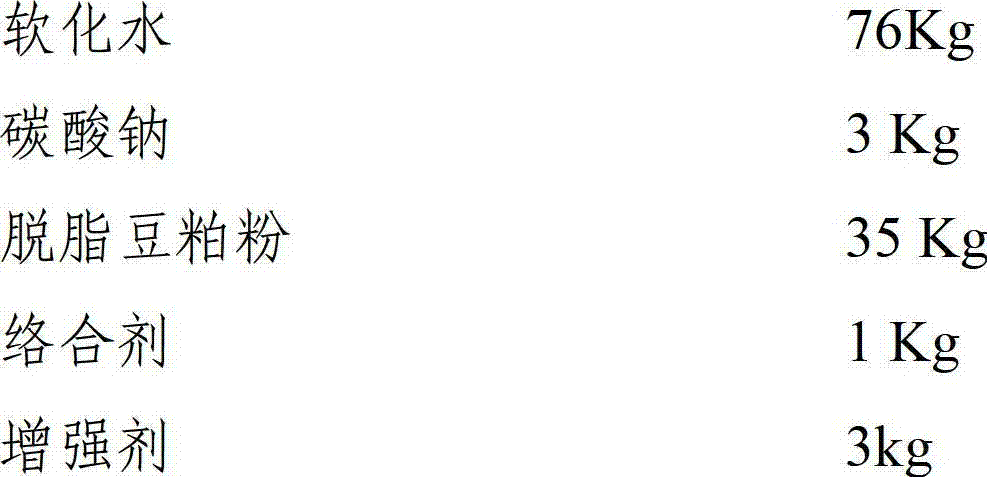Adhesive for artificial board and preparation method of adhesive
A technology for adhesives and wood-based panels, applied in the preparation of adhesives, animal glue or gelatin, adhesive types, etc., can solve the problems of reduced product bonding strength, increased product cost, and reduced production efficiency, so as to solve formaldehyde pollution and meet Water resistance requirements, the effect of comprehensive utilization of resources
- Summary
- Abstract
- Description
- Claims
- Application Information
AI Technical Summary
Problems solved by technology
Method used
Image
Examples
Embodiment 1
[0026] The preparation of embodiment 1 adhesive
[0027] 1) Prepare materials according to the following weight ratio:
[0028]
[0029] Among them, the complexing agent is a powder prepared by the School of Materials Science and Technology of Beijing Forestry University, including zinc chloride: 0.8 parts, copper sulfate: 0.5 parts, zirconium carbonate: 0.5 parts, which are ground and mixed evenly; the reinforcing agent is 80 mesh powder of EVA with 20% vinyl acetate content and a melt index of 20.
[0030] 2) Add all the demineralized water, sodium carbonate and soy protein powder into the reaction kettle equipped with agitator, thermometer and condensing device, and stir evenly.
[0031] 3) Heat to 45-47°C and keep warm for 3 hours.
[0032] 4) The temperature of the reactant was lowered to 30°C to obtain a uniform soy protein mucus.
[0033] 5) Add complexing agent and enhancer to the obtained soy protein mucilage, mix well to make soy protein adhesive. The performa...
Embodiment 2
[0034] The preparation of embodiment 2 adhesive
[0035] 1) Prepare materials according to the following weight ratio:
[0036]
[0037] Among them, the complexing agent is a powder prepared by the School of Materials Science and Technology of Beijing Forestry University, including 1.2 parts of zinc chloride, 1.5 parts of copper sulfate, and 1.5 parts of zirconium carbonate, which are ground and mixed evenly; the reinforcing agent is vinyl acetate. A 100-mesh powder of EVA with a content of 25% and a melt index of 60.
[0038] 2) Add all the demineralized water, sodium carbonate, defatted soybean meal powder into the reaction kettle equipped with agitator, thermometer and condensing device, and stir evenly;
[0039] 3) Heat to 40-42°C and react for 6 hours;
[0040] 4) The temperature of the reactant was lowered to 30°C to obtain a uniform soy protein mucus.
[0041] 5) Add complexing agent and enhancer to the obtained soy protein mucilage, mix well to make soy protein a...
Embodiment 3
[0042] The preparation of embodiment 3 adhesive
[0043] 1) Prepare materials according to the following weight ratio:
[0044]
[0045] Among them, the complexing agent is a powder prepared by the School of Materials Science and Technology, Beijing Forestry University, including the following components in weight proportions: 0.8 parts of zinc chloride, 1.5 parts of copper sulfate, and 1 part of zirconium carbonate, which are ground evenly and mixed Uniform; the reinforcing agent is a 60-mesh powder of EVA with a vinyl acetate content of 40% and a melt index of 100.
[0046] 2) Add all the demineralized water, sodium carbonate and soy protein powder into the reaction kettle equipped with agitator, thermometer and condensing device, and stir evenly.
[0047] 3) Heat to 68-70°C and react for 5 hours.
[0048] 4) The temperature of the reactant was lowered to 30°C to obtain a uniform soy protein mucus.
[0049] 5) Add complexing agent and enhancer to the obtained soy prote...
PUM
 Login to View More
Login to View More Abstract
Description
Claims
Application Information
 Login to View More
Login to View More - R&D
- Intellectual Property
- Life Sciences
- Materials
- Tech Scout
- Unparalleled Data Quality
- Higher Quality Content
- 60% Fewer Hallucinations
Browse by: Latest US Patents, China's latest patents, Technical Efficacy Thesaurus, Application Domain, Technology Topic, Popular Technical Reports.
© 2025 PatSnap. All rights reserved.Legal|Privacy policy|Modern Slavery Act Transparency Statement|Sitemap|About US| Contact US: help@patsnap.com



